 Keeping your business paperwork in order is super important, no matter what job you do. It’s like having all your tools ready when you need them. This is where business documents come in.
Keeping your business paperwork in order is super important, no matter what job you do. It’s like having all your tools ready when you need them. This is where business documents come in.
According to a McKinsey study, employees spend 1.8 hours each day researching for and collecting information. Excellent business documentation can cut this time in half, significantly increasing productivity by up to 20%.
This blog is all about helping you get to know those tools better. Whether you’re just starting out or trying to grow your business, having the right documents is key to keeping things running smoothly.
We’re going to break down what business documents are all about Ready to get started? Let’s jump in!
What are Business Documents?
Business documents are all the written records and digital files that a company uses to organize its activities and communicate. They cover a wide range, from emails and memos to contracts, business plans, and financial statements. These documents are super important because they help keep track of what’s happening in the business, support decision-making, and make sure everyone’s on the same page. Whether it’s setting goals, making deals, or just keeping the daily operations smooth, these documents are the nuts and bolts that hold a business together and keep things moving forward.
Why are Business Documents Important?
Record Keeping:
In order to guarantee a trustworthy verification system for all your finances and historical analysis, they carefully record transactions, decisions, and operational data.
Making Strategic Decisions:
All the important data and insights that are needed for well-informed strategic planning and decision-making are provided by thorough documents and analyses.
Organizational Efficiency:
Standard papers, including project plans and SOPs, provide clear standards and procedures that improve productivity by simplifying operations as well as decreasing errors.
Regulatory Compliance:
By making sure the company complies with relevant laws, standards, and industry rules, legal and compliance documents help to reduce the danger of fines and legal action.
Communication and Coordination:
These documents, which range from internal memos to contracts and SLAs, create clear and consistent channels of communication for internal and external stakeholders, helping partnership and actions that are coordinated.
List of 30 Business Documents
Strategic Planning and Management
This category includes documents such as business plans and strategic roadmaps that help determine a company’s future course. They are known as strategic planning documents because managing and guiding the company’s direction requires some high-level planning and decision-making. So when you are setting long-term objectives, assessing market prospects, or making crucial choices regarding your business, these documents are helpful.
1) Business Plan
 A business plan is a comprehensive document that shows you a company’s objectives and the strategies it will use to meet them. It is like a guide that gives you the direction of the business and includes market positioning, product or service offerings, and financial goals. This is extremely important for both internal clarity and external financing, a business plan facilitates strategic planning and operational decision-making.
A business plan is a comprehensive document that shows you a company’s objectives and the strategies it will use to meet them. It is like a guide that gives you the direction of the business and includes market positioning, product or service offerings, and financial goals. This is extremely important for both internal clarity and external financing, a business plan facilitates strategic planning and operational decision-making.
Key elements of a business plan include:
- Executive Summary: A complete overview or ‘summary’ of the business plan, highlighting key points and objectives.
- Market Analysis: Insights into your relevant industry, target market demographics, competitors, and market trends.
- Company Description: An outline of your business’s vision, mission , goals, and the market needs it promises.
- Organization and Management Structure: Details on the company’s organizational structure, short introduction to the founding members and the management team’s expertise.
- Marketing and Sales Strategies: Techniques or plans used to approach, attract and retain customers, and how sales goals will be achieved.
- Product or Service Line: A description of the products or services you are providing, including details on development, production and lifecycle.
- Funding Request: More details on the amount of funding required currently, potential future funding requirements, and how the current request will be used efficiently for the company’s growth.
- Financial Projections: Forecasts and graphs on revenue, expenses, and profitability, supporting the business’s financial progress.
- Appendix: Any other miscellaneous information like resumes, permits, or detailed studies, supporting the main sections of the plan.
A well-crafted business plan becomes particularly crucial when seeking financial backing. It provides potential investors or lenders with a detailed vision of the business’s roadmap to success, highlighting the opportunity, the team’s expertise, and the expected financial outcomes. This clarity and foresight can significantly enhance the likelihood of obtaining the necessary funding.
2) Strategic Plans
 Strategic plans show what the company wants to do in the future, why it exists, and the big goals it wants to hit. These plans come in handy when a company wants to grow, like moving into a new area. The plan would explain how this big move fits with the company’s main goals. It would also talk about why this is a good idea, what the company needs to make it happen, what problems might occur, and how to tackle them.
Strategic plans show what the company wants to do in the future, why it exists, and the big goals it wants to hit. These plans come in handy when a company wants to grow, like moving into a new area. The plan would explain how this big move fits with the company’s main goals. It would also talk about why this is a good idea, what the company needs to make it happen, what problems might occur, and how to tackle them.
To develop a strategic plan, consider the following steps:
- Vision and Mission: Reflect on your company’s ultimate objectives and its fundamental purpose.
- Current Assessment: Evaluate your company’s strengths, areas for improvement, opportunities for growth, and potential challenges.
- Objective Setting: Determine the key achievements your company aims to realize over the next few years.
- Strategy Formulation: Identify the primary methods you will employ to accomplish these objectives.
- Action Planning: Specify the precise actions required, assign responsibilities, establish timelines, and allocate necessary resources.
- Monitoring Progress: Establish metrics for monitoring progress and be prepared to adjust the plan as necessary to ensure alignment with goals.
3) Minutes of Meeting
 Minutes of Meeting (MOM) business document provide a clear and detailed account of what happens during a board meeting. They’re mainly kept for internal use, helping with records and looking back at past discussions. These minutes are a way to remember and reference the discussions, decisions, and topics that board members tackled during their meeting. They capture the board’s thoughts, agreements, and the steps they plan to take.
Minutes of Meeting (MOM) business document provide a clear and detailed account of what happens during a board meeting. They’re mainly kept for internal use, helping with records and looking back at past discussions. These minutes are a way to remember and reference the discussions, decisions, and topics that board members tackled during their meeting. They capture the board’s thoughts, agreements, and the steps they plan to take.
Sometimes, not everyone invited can make it to the meeting, and that’s okay. The size of your organization and where your board members are located can affect this. It’s also a good idea to check with a legal expert to ensure your meeting minutes meet all the rules and regulations your organization needs to follow.
They usually cover a few important points:
- Date and Time: This is when the meeting happened, from start to finish.
- Meeting Type: Tells us if it was a regular meeting or a special one called for a specific reason.
- Meeting Notice: Notes if everyone was told about the meeting in advance or if it was a last-minute thing.
- Participants: Lists the names of people who were there and who wasn’t.
- Guests: Mentions any guests who joined the meeting.
- Quorum: Checks if enough people were there to make the meeting and decisions official.
- Entry and Exit Logs: Keeps track of anyone who had to step out or come back in during the meeting.
- Reports: Briefly talks about any important reports that were shared.
- Decisions: Highlights the main decisions made and if anyone didn’t agree with them.
- Next Steps: Lists any tasks or actions that people agreed to take on after the meeting.
4) Risk Management Plans
 A risk management plan is a must because it keeps a business operating safely and efficiently. A company that is aware of the dangers and has prepared measures can respond swiftly to issues without causing significant disruptions. These business documents are vital that help companies recognize, evaluate, and manage risks that could be having an effect on their operations. Businesses have to first pinpoint possible risks, such as monetary uncertainties, legal obligations, accidents, or natural disasters, by a thorough procedure before creating these plans.
A risk management plan is a must because it keeps a business operating safely and efficiently. A company that is aware of the dangers and has prepared measures can respond swiftly to issues without causing significant disruptions. These business documents are vital that help companies recognize, evaluate, and manage risks that could be having an effect on their operations. Businesses have to first pinpoint possible risks, such as monetary uncertainties, legal obligations, accidents, or natural disasters, by a thorough procedure before creating these plans.
For example, the risk management plan will describe steps to minimize any disruptions if a business wants to branch out in a country with unstable political conditions. Some of these strategies could be getting insurance against political risk, expanding supply chains to reduce dependency on local suppliers, or creating customizable operating plans.
Sales and Marketing
Documents related to sales and marketing include techniques for attracting customers and promoting products. They are essential for developing campaigns to raise recognition and sales, breaking into new markets, or launching new products.
5) Sales Proposal
 A sales proposal is a critical document that outlines how a company intends to solve a problem or meet the needs of a prospective customer. This document is essential for sales professionals. It explains why their product or service has a specific price and how that cost is a good investment for their success.
A sales proposal is a critical document that outlines how a company intends to solve a problem or meet the needs of a prospective customer. This document is essential for sales professionals. It explains why their product or service has a specific price and how that cost is a good investment for their success.
This could include discussing the qualities and features of the company, benefits of using it, or proving how it is more economical than competitors. A sales proposal is assurance to the client that you as a business provider fully understand their needs, pain spots, or goals.
Here are the things you need to include in your sales proposal:
- Introduction and Executive Summary: Kick off with a brief, compelling overview highlighting the customer’s issue, your solution, and its benefits.
- Problem Statement and Client’s Pain Points: Detail the client’s specific challenges, showing your understanding and empathy.
- Proposed Solution and Methodology: Clearly present your solution, how it works, and why it’s the best option.
- Pricing and Payment Terms: Outline the costs, payment schedule, and methods in clear terms.
- Project Timeline and Deliverables: Define what the client will receive and by when, clarifying the project’s scope.
- Company Background and Credentials: Share your company’s story, mission, key team members, and achievements to build credibility.
- Terms and Conditions: Include legal terms to prevent misunderstandings and protect both parties.
6) Marketing Plan
 A marketing plan is like a map that helps businesses plan out their marketing efforts and keep track of them over time. It’s all about setting up different ways to reach out to customers, with everyone in the company aiming for the same big goals.
A marketing plan is like a map that helps businesses plan out their marketing efforts and keep track of them over time. It’s all about setting up different ways to reach out to customers, with everyone in the company aiming for the same big goals.
The main idea of having a marketing plan is to lay out your marketing ideas clearly. This makes it easier to see if you’re hitting your targets and getting the results you want.
When you write down your marketing plan, you think about the goal of each marketing push, who you want to reach, how much money you’ll spend, the steps you’ll take, and what you’ll make or achieve. Having all this info in one spot helps you stay focused and makes sure your marketing efforts are going in the right direction.
Types of Marketing Plans:
- Digital Marketing Plan: Focuses on online strategies like social media, email, and websites.
- Content Marketing Plan: Plans out the creation and sharing of things like blogs, videos, and social media posts.
- Product Launch Plan: A specific plan for introducing a new product to the market.
- Brand Development Plan: Aims at building or refreshing a company’s image and reputation.
- Social Media Marketing Plan: Concentrates on engaging with customers on platforms like Facebook, Twitter, and Instagram.
- Email Marketing Plan: Involves sending targeted and personalized messages to a list of email subscribers.
- Event Marketing Plan: Focuses on promoting and managing events to engage with customers or clients.
7) Customer Feedback Forms
 Businesses can use a customer feedback form to get feedback and insights from customers regarding their goods, services, or just an overall shopping experience. This form can include questions that request ratings (e.g., on a scale of 1 to 5) as well as open-ended answers, allowing users to provide some additional in-depth information. This business document highlights both the benefits and drawbacks of your company.
Businesses can use a customer feedback form to get feedback and insights from customers regarding their goods, services, or just an overall shopping experience. This form can include questions that request ratings (e.g., on a scale of 1 to 5) as well as open-ended answers, allowing users to provide some additional in-depth information. This business document highlights both the benefits and drawbacks of your company.
Knowing what customers want and experience allows your service to be improved. Requesting input from clients also proves to them that your business values their opinions. Customers are more dependable and loyal as a result.
To improve your feedback form you can:
- Give a Reward: Offer something small, like a discount, coupon code or a chance to win something, for filling out the form.
- Use the Feedback: Tell customers how their comments will actually help make things better. It shows you really listen.
- Say Thanks: Sometimes, reach out to say thanks or ask more about their feedback. It makes customers feel valued.
- Visual Aids: Use pictures or emojis for ratings to make it fun and engaging.
- Accessible Design: Make sure the form is easy to use for people with disabilities.
8) Content/ Social Media Calendars
These days, a content calendar serves as a planner for anything an organization wishes to post online to make its online presence better and more engaging, including emails, blogs, and social media posts. It keeps things organized by helping with the scheduling of what to post, when, and where. This is really helpful for businesses since it maintains a regular web presence and ensures that they are continually communicating with their audience. Additionally, it saves plenty of time as you won’t have to go about at the last minute to find anything to put up. By organizing ahead of time, you can make sure that your content aligns with promotions or special events, increasing the results of your advertising campaigns.
| Day | Platform | Content |
|---|---|---|
| Monday | Instagram Blog |
Post an inspirational quote related to success in sales. Publish "5 Innovative Sales Strategies for the Today’s Sales Market". |
| Tuesday | Facebook Email Newsletter |
Share a video testimonial from a satisfied client. Highlights from the latest sales blog posts and success stories. |
| Wednesday | Instagram Blog |
Share a behind-the-scenes look at a day in the life of a top salesperson. Write about “Building Strong and Long-Term Customer Relationships for Success”. |
| Thursday | Facebook Instagram Story |
Throwback to a major milestone in the company’s sales history progress. Host a live Q&A session on sales techniques and product features. |
| Friday | Instagram Blog |
Announce a special end-of-week discount, coupon code, or promotional offer. Light-hearted post like “Funniest Sales Block Stories from Our Team”. |
| Saturday | Engage followers with a poll on their biggest sales challenges. | |
| Sunday | Post a relaxing image with a message about recharging for another week of sales success. |
The purpose of this content calendar is to keep the audience interested and up-to-date about the company's sales activities and accomplishments by finding a balance between promotional, educational, and entertaining content. Along with the topics make sure you research the best time to post or send according to your customer's viewing time.
9) Marketing Research Reports
A market research report is a detailed document that uncovers who your perfect customers are, what they like to buy, how your product or service fits into their lives, and who you’re up against in the market. It’s like a progress chart that shows you where the best opportunities for new products or services lie in a crowded and competitive field. For stuff that’s already out there, this report dives deep to check if it’s hitting the mark with customers or if it’s missing the spot.
By knowing why people choose certain products, considering everything from their budget to cultural trends and personal preferences, the report gives a comprehensive view of consumer behavior, helping businesses understand and meet their audience’s needs more effectively.
Steps to write a market research report:
- To make sure you’re asking the correct questions and getting to the core of what you need to know, use the appropriate research approach, such as surveys for immediate feedback or data analysis for trends.
- Go deep into gathering data by using surveys, interviews, or dataset analysis, with the goal of obtaining high-quality answers that provide insightful information.
- To turn the raw data into knowledge that can benefit your company, sort through the gathered data to find noteworthy trends, patterns, and insights.
- Create the report by first summarizing the most important findings, then arranging the material in an approachable manner and using illustrations and charts to help make difficult data easier to understand.
- Finish by drawing findings that explain the implications of the data analysis for your business plan and provide specific, doable advice for the future.
Human Resources
Human resources business documents cover everything related to managing the company’s employees and HR policies, from hiring to performance evaluations. They’re called this because they focus on the organization’s workforce, its most valuable resource. These documents are essential for recruitment, employee management, training, and ensuring compliance with labor laws.
10) Employee Agreements
 The official agreement between your organization and its employees is outlined in an employment contract. In order to avoid misunderstandings and establish clear expectations, this contract is extremely essential. It provides a solid basis for the employment relationship by outlining important information such as the compensation, job duties, and working hours.
The official agreement between your organization and its employees is outlined in an employment contract. In order to avoid misunderstandings and establish clear expectations, this contract is extremely essential. It provides a solid basis for the employment relationship by outlining important information such as the compensation, job duties, and working hours.
It serves as a point of reference for the employer and the worker and provides an organized structure for resolving any future disputes. In basic terms, it’s a business’s pledge to equity and openness, making sure that both sides are aware of and approve of the employment terms. Employment contracts in India are subject to a number of laws and rules, such as the Shops and Establishments Act of different states, the Industrial Disputes Act of 1947, and the Indian Contract Act of 1872.
When is an employment contract used?
- Promotions and Role Changes: To revise terms for staff members assuming new positions.
- Starting a New Job: To lay out the guidelines for newly hired staff.
- Company Changes: When work positions are impacted by corporate restructuring.
- Renewing Terms: To prolong work contracts with set durations.
- Modifying Employment Terms: To record major changes such as pay adjustments or shifts in work hours.
11) Job Descriptions
 A job description is a written document that outlines all the necessary tasks, obligations, credentials, and abilities needed for a particular position in a company. It provides clarity on the duties and expectations of the position, making it a useful tool for both employers and prospective employees. This understanding helps in choosing career growth paths, measuring employee performance, and drawing in qualified applicants.
A job description is a written document that outlines all the necessary tasks, obligations, credentials, and abilities needed for a particular position in a company. It provides clarity on the duties and expectations of the position, making it a useful tool for both employers and prospective employees. This understanding helps in choosing career growth paths, measuring employee performance, and drawing in qualified applicants.
Here’s how you outline a job description:
- Job Title: This is placed at the top to immediately clarify the position.
- Department/Location: Follows the job title to provide context about where the job fits within the organization.
- Reports To: Comes next to outline the reporting structure and managerial relationships.
- Job Purpose/Summary: Provides an introductory overview of the role and its importance to the company early in the document.
- Key Responsibilities and Duties: Detailed list of tasks and responsibilities comes after the summary to give a clear picture of day-to-day activities.
- Skills and Qualifications: Follows the responsibilities section, specifying what qualifications and skills are needed to perform the job effectively.
- Work Conditions: Describes the environment and any physical or mental demands associated with the job.
- Physical Requirements: If distinct from general work conditions, details on physical aspects of the job are listed next.
- Core Competencies: Outlines the personal and professional attributes desired in a candidate, linked to the company culture and values.
- Performance Goals: If included, this section outlines expected achievements and targets for the role.
- Employment Type: Indicates whether the job is full-time, part-time, or otherwise, helping candidates understand the commitment required.
- Salary Range: If applicable, the salary range may be mentioned towards the end to provide compensation information.
12) Performance Reviews
 A performance review is a structured process where managers and other important figures in the company assess an employee’s job performance. It’s a chance to highlight what they’re doing well and where they could improve, providing helpful feedback to help them grow their skills and set new goals. This could be weekly, monthly, quarterly or even annual.
A performance review is a structured process where managers and other important figures in the company assess an employee’s job performance. It’s a chance to highlight what they’re doing well and where they could improve, providing helpful feedback to help them grow their skills and set new goals. This could be weekly, monthly, quarterly or even annual.
No matter how you carry out performance reviews, doing them thoughtfully and effectively can really engage your team. It helps build a workplace where feedback and continuous growth are part of the everyday culture, making your organization a place where everyone is geared towards getting better and achieving more. Here’s how you can prepare before a performance review:
- Study Prior Feedback: To gain insight into past performance, review prior goals and ratings.
- Collect Data: Record details on an employee’s accomplishments, difficulties, and input from clients or coworkers.
- Establish Specific Goals: Determine the objectives of this review, such as establishing new targets or tackling certain problems.
- Learn How To Use The Review Tools: Make sure you are familiar with all performance review forms and software.
- Create a Schedule: Schedule the meeting’s subjects, length of time for staff input, and other details.
- Consider Feedback: Contemplate how to present constructive as well as positive feedback in a way that is fair.
- Plan the Review Date: Select a time when you and the employee can be completely focused and undistracted.
13) Employee Handbooks
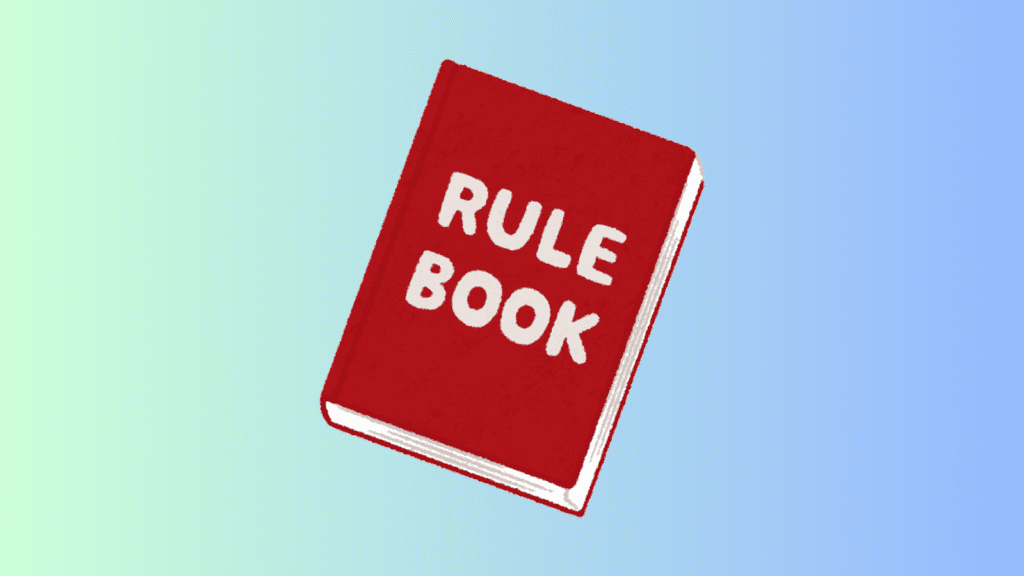 An employee handbook is a book given to employees that explains the rules of the workplace they have just been hired for. It talks about what the company expects from its employees, what employees can expect, the company’s culture and values, and includes important policies like time off and behavior at work.
An employee handbook is a book given to employees that explains the rules of the workplace they have just been hired for. It talks about what the company expects from its employees, what employees can expect, the company’s culture and values, and includes important policies like time off and behavior at work.
In many cases, new hires can get access to the handbook even before they begin work, giving them time to soak up everything at their own speed and be ready with any questions they may have on their first day.
14) Training Manuals
 To increase organizational efficiency, it makes sense to create a well-organized training handbook that gives customers and employees the knowledge and abilities they need to operate at their best. More specifically, it supports a variety of learning contexts and demands through many forms of training, including in-person, remote, on-demand, and just-in-time.
To increase organizational efficiency, it makes sense to create a well-organized training handbook that gives customers and employees the knowledge and abilities they need to operate at their best. More specifically, it supports a variety of learning contexts and demands through many forms of training, including in-person, remote, on-demand, and just-in-time.
Training manuals need to cover all the important details of the subject matter in a concise, understandable, and detailed manner to be effective. To meet the needs of a wide range of learning styles and guarantee that the information is understandable and interesting to all users, they should also include real-world examples, graphic aids, and careful instructions.
Finance and Accounting
This category includes business documents including financial statements, budgets, and audits. It’s named for its focus on tracking and managing the company’s financial health. These business documents are crucial for making informed financial decisions, securing funding, and ensuring regulatory compliance.
15) Budget Reports
 A budget report is another essential business document which describes a company’s financial plan for a given term. This provides projected revenue and expenses, assigns funding to different projects or departments, and guides financial decisions by monitoring performance against targets. It is usually submitted at the conclusion of a certain financial term, such as a month, quarter, or year
A budget report is another essential business document which describes a company’s financial plan for a given term. This provides projected revenue and expenses, assigns funding to different projects or departments, and guides financial decisions by monitoring performance against targets. It is usually submitted at the conclusion of a certain financial term, such as a month, quarter, or year
It could come in handy when evaluating the company’s financial performance and making plans for the upcoming quarter at the quarterly review meeting. At this point, the report highlights areas of overspending or underspending and offers insights into how effectively your company has stuck to its budget. It is very easy to make well-informed judgements on current and future investments, cost-cutting initiatives, and resource reallocation to support the company’s strategic goals.
16) Financial Statements
 Financial statements are detailed business documents that show the financial health of a company. They provide a clear image of a company’s financial status to all parties involved, from investors to executives. Experts such as accountants or government agencies typically review these statements to verify their accuracy, particularly in relation to taxes or in the event that the business is looking for funds or make investments.
Financial statements are detailed business documents that show the financial health of a company. They provide a clear image of a company’s financial status to all parties involved, from investors to executives. Experts such as accountants or government agencies typically review these statements to verify their accuracy, particularly in relation to taxes or in the event that the business is looking for funds or make investments.
The main elements of financial statements for a company are:
- Balance sheet: This displays the assets and liabilities of the company as well as the equity (the remaining value for the owners) at a certain point in time.
- Income statement: Sometimes referred to as the profit and loss statement, it presents the company’s costs, revenues, and expenses during a given time period in order to indicate whether or not it was profitable.
- Statement of Cash Flows: This shows how the company uses its cash by tracking the amount of money coming in and going out of the business.
- Statement of Changes in Equity: This element shows the evolution of the company’s equity over time, including changes in stock, dividend payments, and profits or losses.
17) Invoices
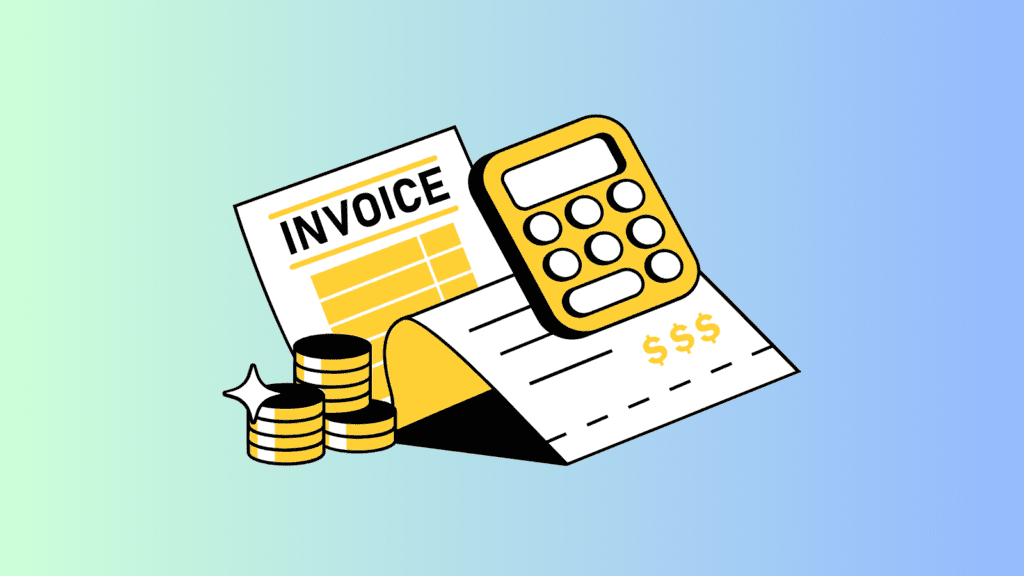 A bill that companies send to their clients or customers to request payment for goods or services is called a corporate invoice. Customers who purchase goods or services on credit—that is, who receive the good or service before making payment—receive invoices from businesses.
A bill that companies send to their clients or customers to request payment for goods or services is called a corporate invoice. Customers who purchase goods or services on credit—that is, who receive the good or service before making payment—receive invoices from businesses.
It works similarly to a complete receipt, including the items purchased, their total cost, and the date of payment. It’s critical to make sure that all invoices are easy to read, comprehensive, and clear for efficient billing. To prevent payment delays, they should always be sent out as soon as a service is given. In order to keep the company’s cash flow consistent, it’s a good idea to follow up on invoices that aren’t paid by the deadline.
An invoice needs to have the following information:
- Company Information: Your company’s name, address, and phone number.
- Information about the Customer: Name and address of the customer.
- Invoice Number: An individual tracking number.
- Date: The day the bill was sent out.
- Description of Goods/Services: Overview of the goods or services includes the items sold, their prices, and quantities.
- Total Sum Due: With taxes or savings included.
- Terms of Payment: How and when should I make my payment?
18) Audit Reports
 A company audit report business documents are like a financial health check done by someone outside the company to make sure all the money matters are in order. It looks at how accurate the company’s money records are, if the company is following the financial rules, and if it’s keeping a good watch on its finances. The report will say what the auditor thinks about the company’s finances, point out any problems, and might suggest ways to fix them. Usually, companies have to do this kind of check-up every year to follow the law, keep investors happy, or get ready for tax time.
A company audit report business documents are like a financial health check done by someone outside the company to make sure all the money matters are in order. It looks at how accurate the company’s money records are, if the company is following the financial rules, and if it’s keeping a good watch on its finances. The report will say what the auditor thinks about the company’s finances, point out any problems, and might suggest ways to fix them. Usually, companies have to do this kind of check-up every year to follow the law, keep investors happy, or get ready for tax time.
19) Profit and Loss Statements
 A profit and loss (P&L) statement, which shows whether a business earned money (profit) or lost money (loss) over a specific time period, such as a month or a year, is similar to a financial ‘report card’ for a company.
A profit and loss (P&L) statement, which shows whether a business earned money (profit) or lost money (loss) over a specific time period, such as a month or a year, is similar to a financial ‘report card’ for a company.
The profit and loss statement (P&L) shows all the money a business receives from sales of products or services (revenues) and deducts all the expenditures and expenses, such as labor and materials, that go along with generating those sales. The final result then indicates the profit or loss for the business.
A comprehensive P&L statement will need to include:
- Revenue: The amount of money received through sales.
- COGS (cost of goods sold): Expenses directly related to producing the goods that are sold.
- Gross Profit: Revenue minus COGS.
- Operating Expenses: Costs that are expenses like rent and advertising which are not directly related to producing goods.
Operating Income: It is calculated as gross profit less operating costs. - Other Revenue and Expenses: Funds received from sources other than operations, such as interest.
- Net Profit or Loss: The total profit or loss following all costs and income.
Operations and Project Management
Theses business documents in this category help in the planning, executing, and tracking of business operations and projects. They’re essential for ensuring that daily activities align with strategic goals, resources are used efficiently, and projects are completed on time and within budget.
20) Project Plans
 A project plan are in-depth business documents that covers all the requirements needed to carry out a project properly. Putting together a project plan requires extensive research and thoughtful decision-making regarding your project’s methodology. It’s a team effort that usually uses suggestions from multiple parties and team members. After it is finished, the project plan is a key tool for monitoring the project’s advancement, making sure that everyone works towards the same objectives, and helping in the project’s successful conclusion.
A project plan are in-depth business documents that covers all the requirements needed to carry out a project properly. Putting together a project plan requires extensive research and thoughtful decision-making regarding your project’s methodology. It’s a team effort that usually uses suggestions from multiple parties and team members. After it is finished, the project plan is a key tool for monitoring the project’s advancement, making sure that everyone works towards the same objectives, and helping in the project’s successful conclusion.
A project plan covers these essentials elements of a project:
- Scope: This bit explains what the project is trying to do, what’s going to be made, and what’s not included.
- Cost: It talks about the project’s budget, covering all the costs to make sure money matters stay in line.
- Schedule: This part lists all the jobs to be done, when they should be finished, and who’s responsible. It keeps everything running on time.
- Risk Management: Here, the plan points out what could go wrong and how to dodge or deal with these issues.
- Resource Management: This section lays out all the stuff and people needed for the project and how they’ll be used.
- Communications: It also explains how everyone involved will talk to each other, making sure no one’s left out of the loop.
21) Standard Operating Procedures (SOPs)
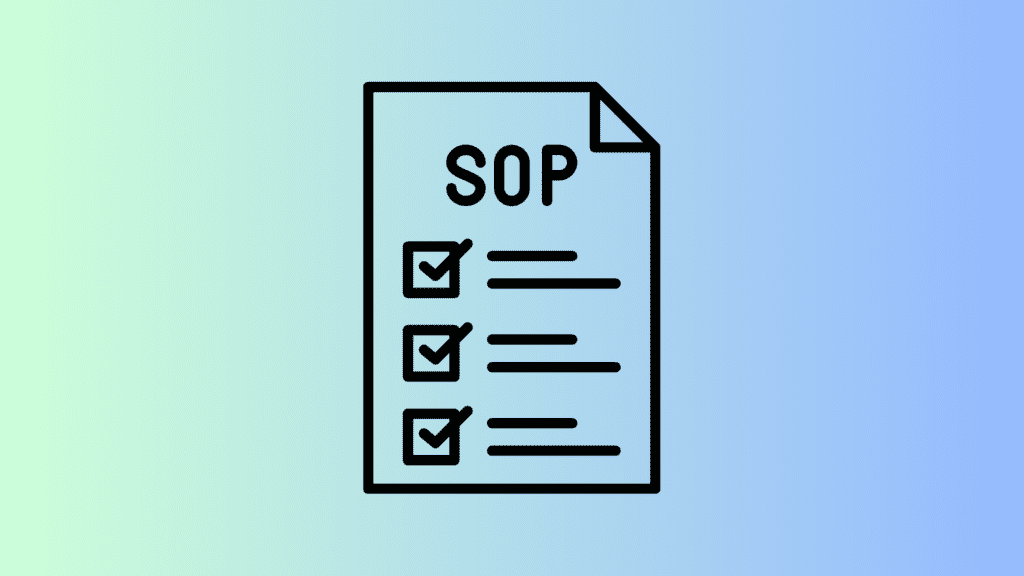 Standard Operating Procedures or SOPs are business documents that describe the step-by-step process required to complete a task or activity within an organization. SOPs are commonly used in various industries such as manufacturing, healthcare, hospitality, and finance.
Standard Operating Procedures or SOPs are business documents that describe the step-by-step process required to complete a task or activity within an organization. SOPs are commonly used in various industries such as manufacturing, healthcare, hospitality, and finance.
By creating clear and concise SOPs, you can not only ensure that your employees understand their roles and responsibilities but also improve your sales performance.
Here’s a list of some essential SOPs that fit across various industries:
- Onboarding and Orientation
- Performance Evaluations
- Employee Offboarding
- Financial Reporting
- Emergency Response and Safety Procedures
- Customer Service Standards
- Data Privacy and Security
- Inventory Management
- Equipment Maintenance and Usage
- Travel and Expense Reporting
- IT and Software Usage
- Conflict Resolution and Complaint Handling
- Quality Assurance and Control
- Procurement and Vendor Management
- Workplace Ethics and Conduct
- Health and Environmental Compliance
- Project Management Processes
- Sales and Marketing Procedures
- Human Resources Policies
- Product Development and Launch
If you wish to know more in depth about SOP’s you need to make your business super efficient check out our blog on Sales Standard Operating Procedures and some best practices.
22) Quality Assurance Documents
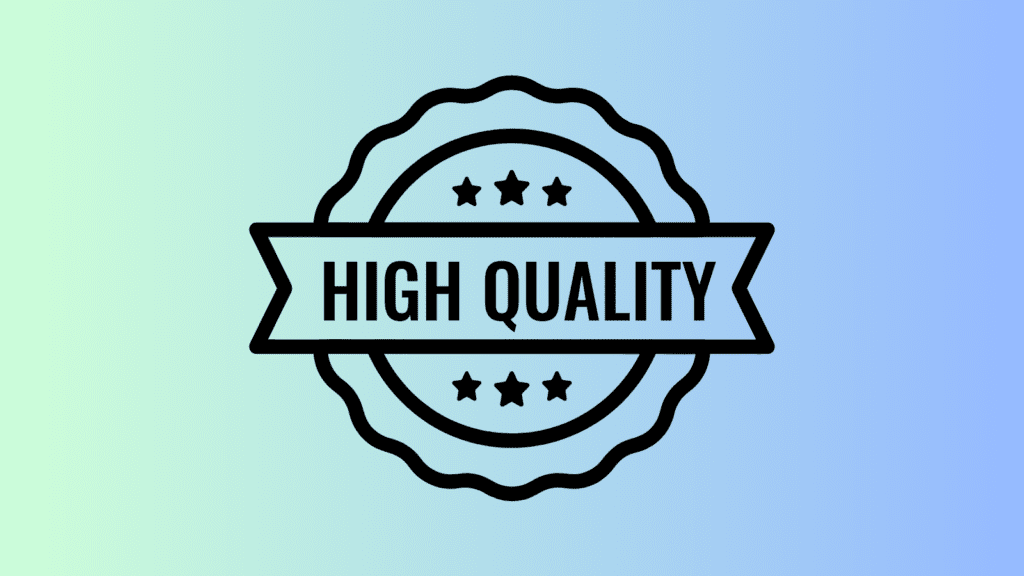 Mistakes can happen at any step in creating software, and they can lead to small or big problems. Quality Assurance (QA) helps us find and fix these mistakes, making the products better and safer. By doing QA tests from start to finish, we make sure the software is not only good quality but also works well and reliably. The QA team works hard to check that a product/service does everything it’s supposed to do and doesn’t do anything it shouldn’t.
Mistakes can happen at any step in creating software, and they can lead to small or big problems. Quality Assurance (QA) helps us find and fix these mistakes, making the products better and safer. By doing QA tests from start to finish, we make sure the software is not only good quality but also works well and reliably. The QA team works hard to check that a product/service does everything it’s supposed to do and doesn’t do anything it shouldn’t.
QA documentation for any kind of company should include:
- Test Plan: Describes the testing approach, objectives, and schedule, directing the quality assurance procedure from beginning to end.
- Checklist: An inventory of things and functionalities that need to be verified as complete.
- Test Case: Specifies the exact scenarios to be tested, together with the actions to do, the results to be expected, and the requirements to pass or fail.
- Bug Report: Contains information regarding any errors discovered, such as the cause of the problem, how to recreate it, and any recommended solutions.
- Traceability Matrix: Provides that every requirement is tested and matched to its corresponding test.
- Test Report: Gives a summary of the software’s quality by summarising the testing results, including passed and failed tests.
23) Health and Safety Guidelines
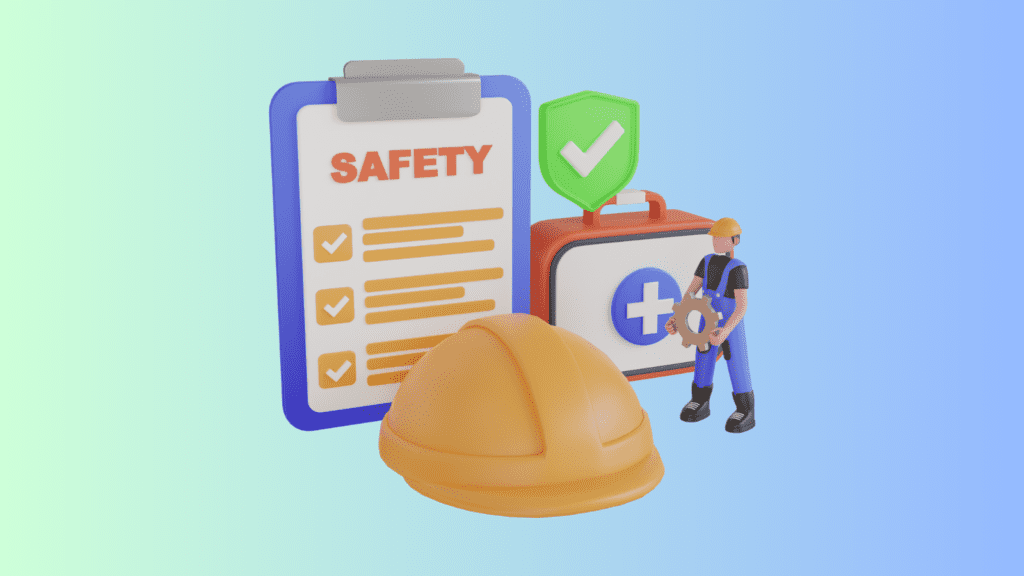 Keeping up with all the safety paperwork and records is key to making sure your employees stay safe and healthy. It also helps your business stick to the rules and safety codes. Health and safety documents are super important for creating a safe place to work. They help stop accidents and sickness at work and make sure your business follows the law and other rules. Some key health and safety documents every workplace needs are:
Keeping up with all the safety paperwork and records is key to making sure your employees stay safe and healthy. It also helps your business stick to the rules and safety codes. Health and safety documents are super important for creating a safe place to work. They help stop accidents and sickness at work and make sure your business follows the law and other rules. Some key health and safety documents every workplace needs are:
- Emergency Plans: These lay out what to do in emergencies like fires or accidents to keep everyone safe.
- Ergonomics Guides: These focus on making sure your workspace fits you well, so you don’t get sore or injured.
- Hazard Guides: These explain how to handle dangerous materials correctly and safely.
- Incident Reports: These are forms where you write down what happened if there’s an accident or close call at work.
- Safety Manuals: These books tell you how to stay safe at work, covering everything from general rules to how to use equipment safely.
- Training Manuals: These help with safety training, giving clear steps on how to work without getting hurt.
24) Purchase Orders
 Often known as a PO, it is a legal document that specifies the terms of a transaction between a buyer and a supplier or vendor. The document provides information regarding the specifics of the items that are to be acquired.
Often known as a PO, it is a legal document that specifies the terms of a transaction between a buyer and a supplier or vendor. The document provides information regarding the specifics of the items that are to be acquired.
This will include the kinds of commodities, the amount, and the cost of each item. Every PO is assigned a one-of-a-kind number that both the buyer and the seller can use to trace the status of their deliveries and payments.
The purchase order process looks like this
- Initiation: The need for a product or service prompts the purchasing department to create a purchase order (PO). For regular purchases, a PO may be generated automatically.
- Approval: The finance department reviews the PO. Approval processes vary by company, determining who must authorize the purchase.
- Submission: The approved PO is sent to the supplier, becoming a binding contract upon acceptance.
- Shipping and Inspection: The supplier dispatches the items, subject to quality inspection upon arrival. Any discrepancies are reported to the supplier.
- Three-Way Matching: Before payment, a three-way match between the PO, the received goods, and the supplier’s invoice ensures accuracy.
- Closure: Satisfaction with the order leads to PO closure, and the finance department proceeds with payment to the supplier.
Legal and Compliance
These business documents ensure that a company’s operations are in line with legal requirements and industry standards. This category is crucial for mitigating legal risks, protecting intellectual property, and ensuring that the business operates within the law.
25) Non-Disclosure Agreements (NDAs)
 A non-disclosure agreement (NDA) in India according to the Indian Contract Act 1872 is an important way to protect the intellectual property of your business.
A non-disclosure agreement (NDA) in India according to the Indian Contract Act 1872 is an important way to protect the intellectual property of your business.
Although mostly used in business collaborations, Non-Disclosure Agreements also help companies during possible partnerships, new hires etc.
When it’s an employees signing the NDA, it is to make sure they keep their company’s private information, like special methods or business strategies, confidential. Hence it is also known as a confidentiality agreement. The core purpose of an Non-Disclosure Agreement business documents is to guard important information against being leaked to competitors or the public, helping to maintain a company’s competitive edge and mutual trust among the parties involved.
Writing an NDA can be simple if you follow these steps:
- Define Confidentiality: Decide what information is private. An NDA should protect anything that’s obviously confidential.
- Responsibilities: Spell out how the receiver of the information will keep it secret and prevent leaks.
- Exclusions: Clarify when it’s okay to share confidential info, like during legal issues or with subcontractors.
- Duration: Agree on how long the NDA lasts. Some want it forever, others for a set time. Make sure everyone’s clear on this.
- Consequences: Decide what happens if the NDA is broken. This could mean ending a job or partnership, or even taking legal action for a breach.
26) Supplier Contracts
 Business documents or agreements between a company and a supplier of products or services is known as a supplier contract. It outlines the goods and services the supplier will offer as well as the payment terms the company will accept from the supplier. Important information like delivery schedules, product quality, and terms of payment are also covered in the contract. Everything works more smoothly when there are no misconceptions and all parties are clear about what is expected of them.
Business documents or agreements between a company and a supplier of products or services is known as a supplier contract. It outlines the goods and services the supplier will offer as well as the payment terms the company will accept from the supplier. Important information like delivery schedules, product quality, and terms of payment are also covered in the contract. Everything works more smoothly when there are no misconceptions and all parties are clear about what is expected of them.
Generally, a supplier contract has the following terms:
- Description of Goods/Services: A brief summary of the goods or services that the supplier offers.
- Pricing and Terms of Payment: What items cost and when payments will be due.
- Delivery Schedule: The time and method of delivery for the products or services.
- Quality Standards: The estimated level of quality or requirements for the products or services.
- Warranty: Guarantee regarding the state of the product or quality of the service.
- Termination Conditions: When and how the agreement could be terminated.
- Confidentiality: How the privacy of particular information between parties is going to be maintained.
Product Development and Research
This category encompasses business documents related to creating new products or improving existing ones, including research reports and product specifications. They’re vital for innovation, staying competitive, and meeting customer needs.
27) Technical Specifications
 Technical requirements for goods, services, or projects are described in depth in technical specifications. In order to make sure that what is being developed or provided satisfies specified criteria, which is essential for quality control, consistency, and fulfilling consumer expectations, they set explicit standards and rules. For this reason, they are very important.
Technical requirements for goods, services, or projects are described in depth in technical specifications. In order to make sure that what is being developed or provided satisfies specified criteria, which is essential for quality control, consistency, and fulfilling consumer expectations, they set explicit standards and rules. For this reason, they are very important.
In industries including manufacturing, engineering, technology, and construction, these business documents are frequently used. They are crucial for establishing exact specifications for goods, systems, services, and materials in order to guarantee consistency, quality, and adherence to industry norms.
28) Product Development Plans
 From the first concept to the ultimate market launch, a product must go through many stages of development. This is called as the product development plan. A carefully thought-out plan for product development not only directs the product from conception to market, but it also coordinates teamwork, controls risks, and lays the groundwork for an effective product launch. Prior to the project receiving substantial funding, the strategy is usually developed in the early stages of product development, frequently during the ideation stage.
From the first concept to the ultimate market launch, a product must go through many stages of development. This is called as the product development plan. A carefully thought-out plan for product development not only directs the product from conception to market, but it also coordinates teamwork, controls risks, and lays the groundwork for an effective product launch. Prior to the project receiving substantial funding, the strategy is usually developed in the early stages of product development, frequently during the ideation stage.
The crucial phases in product development are:
- Idea generation: It is the process of coming up with concepts for new products using market analysis, feedback, and brainstorming.
- Concept screening: This is the process of selecting the best concepts based on their viability and potential marketability.
- Concept Development and Testing: It is refining the most promising concepts, creating prototypes, and getting feedback from possible users.
- Business analysis: Determining the viability of a product idea by examining expenses, projected sales, and possible earnings.
- Product Design and Development: Next you will be creating the ultimate design and preparing it for mass production.
- Market testing: This is the process of introducing a product to a limited number of people to measure interest and gather feedback.
- Commercialization: Planning marketing strategies and producing additional goods in preparation for the product launch.
- Post-Launch Review: Lastly you need to monitor the product’s performance following its release and making any necessary adjustments.
29) Research Reports
 A research report is a comprehensive business document that provides the findings of a particular study or inquiry in the context of business. Strategic planning and decision-making get help greatly from such a report’s insights on consumer behavior, market trends, industry advancements, and product viability. It is usually made when a company has to make a decision that calls for extensive research or while looking into new possibilities.
A research report is a comprehensive business document that provides the findings of a particular study or inquiry in the context of business. Strategic planning and decision-making get help greatly from such a report’s insights on consumer behavior, market trends, industry advancements, and product viability. It is usually made when a company has to make a decision that calls for extensive research or while looking into new possibilities.
It could also come before a new product is introduced, before a company enters a new market, or before any other strategic initiative that calls for evidence-based decision-making. When finished, the study report is distributed to important parties, like investors, department heads, and management teams, to help them make decisions.
Customer Service and Support
The business documents here focus on assisting and engaging with customers, such as service agreements and feedback forms. This category is key for maintaining customer satisfaction, resolving issues, and building strong relationships with the client base.
30) Service Level Agreements (SLAs)
 A service level agreement (SLA) is a contract between a service provider and a customer that describes the level of service provided by the provider. These contracts are commonly used in the technology industry, but can also be used in other industries serving customers. This section describes the use and benefits of Service Level Agreements.
A service level agreement (SLA) is a contract between a service provider and a customer that describes the level of service provided by the provider. These contracts are commonly used in the technology industry, but can also be used in other industries serving customers. This section describes the use and benefits of Service Level Agreements.
Service level agreements typically include details such as service coverage, performance metrics, and corrective actions in the event of non-compliance. The contract outlines the expectations of both provider and customer and ensures that both parties understand the level of service to be provided. SLAs also provide a framework for measuring and monitoring service performance.
31) User Manuals
 A user manual are helpful business documents created to instruct users on how to get the most out of a product or service. It’s an important resource that improves the user experience by offering precise directions, hints, and troubleshooting recommendations.
A user manual are helpful business documents created to instruct users on how to get the most out of a product or service. It’s an important resource that improves the user experience by offering precise directions, hints, and troubleshooting recommendations.
A user manual comes in particularly handy for customers buying new smartphones. They can follow the manual’s instructions for initial setup, which include starting the phone and installing a SIM card. It also covers features like using the advanced settings on the camera or configuring fingerprint recognition that they might not be aware of. The troubleshooting area can provide quick fixes for common problems that customers can face, such as a non-charging phone, which could reduce the need for a customer care call.
Conclusion
To wrap it up, business documents are your company’s secret superpower. When done right, they’re the magic key to smoother operations, smarter decisions, and solid growth. But remember, lack of a good grip at documentation could also prove very harmful to you.
This is where we at Smart Sales Kit could prove really useful for you. Professionally crafted and at your fingertips, these documents can transform the way your business runs, turning everyday challenges into opportunities for success. Head out to our website to learn more!
What are business documents?
Plans, agreements, financial statements, reports, and other official papers that support corporate operations are referred to as business documents. They support planning, coordinating, and adhering to legal obligations.
What should be included in a business plan?
An executive summary, firm description, market analysis, organizational structure, product or service line, marketing strategy, funding requirements, and financial predictions should all be included in a business plan.
How do business documents aid in strategic planning?
Business documents track progress, offer crucial information and insights, make it easier to communicate ideas, and guarantee that objectives and activities are in line throughout the company.
How do I ensure compliance with regulatory requirements through documentation?
Maintaining correct records, updating paperwork frequently to reflect new rules and regulations, and performing recurring audits to confirm conformity with the law are all ways to ensure compliance.




